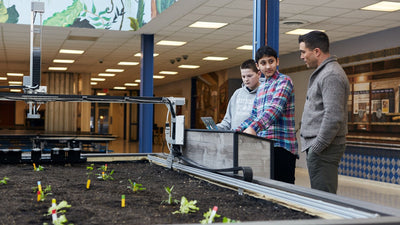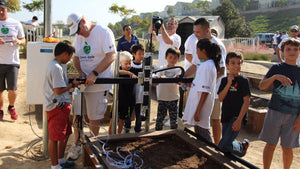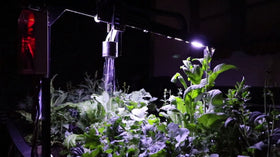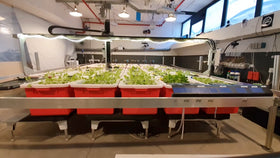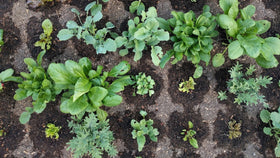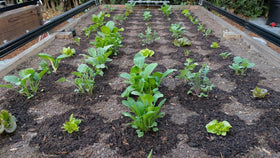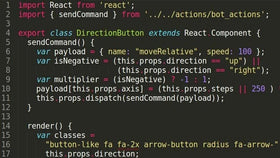Not applicable to Net 30 POs
What is FarmBot’s Return on Investment?
Dive into the economics of FarmBot to see how it compares to the average US grocery store
Reading time: 8 minutes
Many people think that having an expensive piece of farming equipment like FarmBot at your home will never pay for itself – that we would all be better off financially by simply buying fresh veggies at the grocery store. In this post we’ll look at the financial costs associated with purchasing veggies at the grocery store vs owning and operating a FarmBot at your home. First we’ll run the numbers with FarmBot Express (1.2 x 3m) and then look at how the return on investment calculations apply to Express XL and Express MAX.
There are many assumptions we’ll be making in this analysis. Most assumptions are linked to a source at the bottom of this page for where we found the information while others are just realistic guesses. Guesses are marked with an asterisk. For your specific use case, you may want to adjust some of these assumptions and run the numbers yourself to gain a more accurate understanding of the economics of FarmBot and you.
Analyzing Direct Costs
From our analysis of how much food FarmBot can grow, we’re going to work with a yield of 1 cup of veggies per day per square meter [1], or 30 cups/month/m2. Because Express covers 3.6 m2, that means it could yield 108 cups/month. The table below shows the monthly direct costs of producing this much food with FarmBot vs buying an equal amount at the grocery store.
| FarmBot Express Veggies | Store Bought Veggies | ||||
| Factor | Cost | Frequency/Month | Subtotal | Frequency/Month | Subtotal |
| Vegetables | $0.50/cup [2] | 108 [1] | $0.00 | 108 | $54.00 |
| Seeds | $2.00/package* | 3* | $6.00 | – | $0.00 |
| Water | $0.015/gallon [3] | 150* | $2.25 | – | $0.00 |
| Electricity | $0.12/kWh [4] | 8.6 [5] | $1.03 | – | $0.00 |
| TOTAL cost/month | $9.28 | TOTAL cost/month | $54.00 | ||
| TOTAL cost/year | $111.36 | TOTAL cost/year | $648.00 | ||
Using the data above, one would save approximately $45/month, or $540/year in direct costs by growing their own veggies with FarmBot Express vs buying them at the store. If FarmBot Express costs approximately $2,000 (kit + shipping + taxes + supporting infrastructure + soil, etc) then this would indicate a return on investment period of under four years. However, this is not a complete picture because it does not take into account indirect costs such as fuel consumption when traveling to the store, the time required to shop for veggies vs harvest them from FarmBot, or the social cost of CO2 emissions. So let’s look at what the cost savings and ROI of FarmBot Express are when taking into account indirect costs as well.
Looking at direct costs only, the ROI period of FarmBot Express is under four years
Considering Indirect Costs
Many of the indirect costs in this calculation are based on valuing a person’s time. We’re going to use an hourly rate from an average middle class person making $50,000/year, or $25/hour. We’re also going to go out on a limb and suggest (based on conversations with FarmBot customers) that most people will be using FarmBot to grow vegetables with organic practices. Thus, the $0.50/cup cost of veggies we used in the table above needs to be adjusted to level the playing field. Because organic food sales account for less than 5% of all food sales in the US [6], we can assume that the $0.50/cup price is largely reflective of conventionally grown produce. So let’s tack on a premium of 30%, or $0.15/cup to account for going organic. A few other notable assumptions include using a 25 MPG vehicle for travelling to and from the store, and using a social cost of CO2 emissions of $220 per metric ton [9].
| FarmBot Express Veggies | Store Bought Veggies | ||||
| Factor | Cost | Frequency/Month | Subtotal | Frequency/Month | Subtotal |
| Vegetables | $0.50/cup | 108 | $0.00 | 108 | $54.00 |
| Organic markup (30%) | $0.15/cup | 108 | $0.00 | 108 | $16.20 |
| Seeds | $2.00/package | 3 | $6.00 | – | $0.00 |
| Water | $0.015/gallon | 150 | $2.25 | – | $0.00 |
| Electricity | $0.12/kWh | 8.6 | $1.03 | – | $0.00 |
| Transportation to and from store in vehicle
– 6.8 miles [7] at $0.59/mile [8] |
$4.01/trip | – | $0.00 | 4 | $16.04 |
| CO2 emitted by vehicle transport to store
– Using a 25* MPG vehicle |
$0.22/kg [9] | – | $0.00 | 9.7 | $2.13 |
| CO2 emitted in production of veggies | $0.22/kg [9] | 5 [5] | $1.10 | 6.8 [5] | $1.50 |
| Time to purchase veggies (transport and in-store)
– 1 hour* at $25.00/hr* |
$25.00/trip | – | $0.00 | 4 | $100.00 |
| Time to harvest veggies each day
– 5* minutes at $25.00/hr* |
$2.08/harvest | 30 | $62.40 | – | $0.00 |
| Time to maintenance FarmBot
– 30* minutes at $25.00/hr* |
$12.50/session | 1 | $12.50 | – | $0.00 |
| TOTAL cost/month | $85.28 | TOTAL cost/month | $189.87 | ||
| TOTAL cost/year | $1,023.38 | TOTAL cost/year | $2,278.44 | ||
With these numbers, one would save approximately $105/month, or $1,250/year by growing their own veggies with FarmBot Express vs buying an equal amount at the store. If FarmBot Express costs approximately $2,000 (kit + shipping + taxes + supporting infrastructure + soil, etc) + another $100 for installation time including building the raised bed (4 hours at $25/hour) then we’re looking at a total investment of $2,100. Thus, FarmBot Express could have a return on investment period that is less than two years.
Considering both direct and indirect costs, the ROI period of FarmBot Express is under two years
Scaling up Reduces the ROI Period
Now that we have calculated a rough return on investment period for FarmBot Express (1.2 x 3m), let’s take our model and apply it to FarmBot Express XL (2.4m x 6m). FarmBot Express XL can tend to 4x the growing area of FarmBot Express, so let’s assume that all of the ongoing costs (seeds, water, electricity) as well as the yield will be quadrupled. Meanwhile we’ll project the setup time, embodied energy, and initial cost to be 50% more than the smaller sized device. We'll double the time we dedicate to harvesting, but we’ll keep the theoretical time spent at the grocery store to be the same. And here are the numbers for FarmBot Express XL:
| FarmBot Express XL Veggies | Store Bought Veggies | ||||
| Factor | Cost | Frequency/Month | Subtotal | Frequency/Month | Subtotal |
| Vegetables | $0.50/cup | 432 | $0.00 | 432 | $216.00 |
| Organic markup (30%) | $0.15/cup | 432 | $0.00 | 432 | $64.80 |
| Seeds | $2.00/package | 12 | $24.00 | – | $0.00 |
| Water | $0.015/gallon | 600 | $9.00 | – | $0.00 |
| Electricity | $0.12/kWh | 34.4 | $4.12 | – | $0.00 |
| Transportation to and from store in vehicle
– 6.8 miles [7] at $0.59/mile [8] |
$4.01/trip | – | $0.00 | 4 | $16.04 |
| CO2 emitted by vehicle transport to store
– Using a 25* MPG vehicle |
$0.22/kg [9] | – | $0.00 | 9.7 | $2.13 |
| CO2 emitted in production of veggies | $0.22/kg [9] | 20 [5] | $4.40 | 27.2 [5] | $6.00 |
| Time to purchase veggies (transport and in-store)
– 1 hour* at $25.00/hr* |
$25.00/trip | – | $0.00 | 4 | $100.00 |
| Time to harvest veggies each day
– 10* minutes at $25.00/hr* |
$4.17/harvest | 30 | $125.00 | – | $0.00 |
| Time to maintenance FarmBot
– 30* minutes at $25.00/hr* |
$12.50/session | 1 | $12.50 | – | $0.00 |
| TOTAL cost/month | $179.02 | TOTAL cost/month | $404.97 | ||
| TOTAL cost/year | $2,148.24 | TOTAL cost/year | $4,859.64 | ||
With these numbers, one would save approximately $225/month, or about $2,700/year by growing their own veggies with FarmBot Express XL vs buying an equal amount at the store. If a FarmBot Express XL kit costs approximately $2,500 (kit + shipping + taxes + supporting infrastructure, soil, etc) + another $150 for installation time including building the raised bed (6 hours at $25/hour) then we’re looking at a total investment of $2,650. Thus, FarmBot Express XL could have a return on investment period that is about one year.
Considering both direct and indirect costs, the ROI period of FarmBot Express XL is about one year
Scaling to the MAX
Now let's see how things change when we take FarmBot to the limit and go with an Express MAX device. Express MAX covers three times the area of Express XL, so we'll scale the same factors by three more this time. We'll keep the seeds factor constant though, because at this point you're probably buying bulk seeds and the cost will be pretty low.
| FarmBot Express MAX Veggies | Store Bought Veggies | ||||
| Factor | Cost | Frequency/Month | Subtotal | Frequency/Month | Subtotal |
| Vegetables | $0.50/cup | 1,296 | $0.00 | 1,296 | $648.00 |
| Organic markup (30%) | $0.15/cup | 1,296 | $0.00 | 1,296 | $194.40 |
| Seeds | $2.00/package | 12 | $24.00 | – | $0.00 |
| Water | $0.015/gallon | 1,800 | $27.00 | – | $0.00 |
| Electricity | $0.12/kWh | 103.2 | $12.36 | – | $0.00 |
| Transportation to and from store in vehicle
– 6.8 miles [7] at $0.59/mile [8] |
$4.01/trip | – | $0.00 | 4 | $16.04 |
| CO2 emitted by vehicle transport to store
– Using a 25* MPG vehicle |
$0.22/kg [9] | – | $0.00 | 9.7 | $2.13 |
| CO2 emitted in production of veggies | $0.22/kg [9] | 60 [5] | $13.20 | 81.6 [5] | $18.00 |
| Time to purchase veggies (transport and in-store)
– 1 hour* at $25.00/hr* |
$25.00/trip | – | $0.00 | 4 | $100.00 |
| Time to harvest veggies each day
– 20* minutes at $25.00/hr* |
$8.33/harvest | 30 | $250.00 | – | $0.00 |
| Time to maintenance FarmBot
– 30* minutes at $25.00/hr* |
$12.50/session | 1 | $12.50 | – | $0.00 |
| TOTAL cost/month | $364.06 | TOTAL cost/month | $978.57 | ||
| TOTAL cost/year | $4,368.72 | TOTAL cost/year | $11,742.84 | ||
With these numbers, one would save approximately $615/month, or about $7,380/year by growing their own veggies with FarmBot Express MAX vs buying an equal amount at the store. If a FarmBot Express MAX kit costs approximately $3,500 (kit + shipping + taxes + supporting infrastructure, soil, etc) + another $250 for installation time including building the raised bed (10 hours at $25/hour) then we’re looking at a total investment of $3,750. Thus, FarmBot Express MAX could have a return on investment period that is around 6 months.
Considering both direct and indirect costs, the ROI period of FarmBot Express MAX is around 6 months
Closing Thoughts
Now some might be saying that they are not responsible for their CO2 emissions, or that they don’t buy organic, or that they would go to the grocery store even if they did have a FarmBot so they could buy other goods. If any of these cases are true, then your ROI period will be different than what we have suggested. If you value your time differently, normally ride a bike to the store, or power FarmBot with solar, then these numbers will be different for you too. To best understand the economics of owning a FarmBot, we suggest looking at these example calculations and plugging in numbers that more accurately reflect you and your lifestyle.
Something else to note is that these calculations do not account for things that have no clear dollar value. For example, what is the value you place on self reliance and owning the food production process that sustains you? What is the value of eating fresh, local vegetables grown right in your backyard? What is the value of being more connected with your food? What is the value of having a really cool farming robot in your front yard that impresses your friends and family every time they come over? We’ll let you decide!




